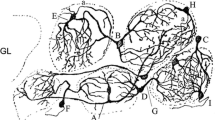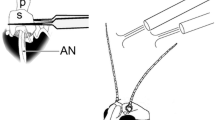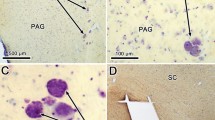Summary
The olfactory mucosa of frog has been studied at an ultrastructural level to confirm previous light microscope observations in regard to the presence, in the sensory epithelium, of nerve fibres not belonging to the first cranial nerve proper. It has been observed that both myelinated and unmyelinated nerve fibres are present in the lamina propria and that eventually these fibres terminate inside the epithelium. Unmyelinated fibres usually contain dark core vesicles and similar content is seen in their intraepithelium terminals. Terminals containing only clear vesicles are also observed in the epithelium and they are believed to represent the terminals of the myelinated fibres. The significance of these ultrastructural findings is discussed in view of their functional meaning.
Similar content being viewed by others
References
Andres, K. H.: In Discussion following paper by Moulton et al. In: Taste and smell in vertebrates (G. E. W. Wolstenholme and J. Knight, eds.), p. 247–248. London: Churchill 1970.
Berger, B.: Ultrastructure de la couche superficielle du bulbe olfactif principal chez le lapin. Arch. Anat. micr. Morph. exp. 58, 41–62 (1969).
Brunn, A. von: Beiträge zur mikroskopischen Anatomie der menschlichen Nasenhöhle. Arch. mikr. Anat. 39, 632–651 (1892).
Cajal, S. R.: Histologie du système nerveux de l'Homme et des Vertébrés. Madrid, Spain: Instituto Ramon y Cajal 1952.
de Lorenzo, A. J. D.: The olfactory neuron and the blood-brain barrier. In: Taste and smell in vertebrates (G. E. W. Wolstenholme and J. Knight, eds.), p. 151–176. London: Churchill 1970.
Gasser, H. S.: Olfactory nerve fibers. J. gen. Physiol. 39, 473–496 (1956).
Grassi, V., Castronuovo, A.: Beiträge zur Kenntnis des Geruchsorgans des Hundes. Arch. mikr. Anat. 34, 385–390 (1889).
Graziadei, P. P. C.: Topological relations between olfactory neurons. Z. Zellforsch. 118, 449–466 (1971a).
Graziadei, P. P. C.: The olfactory mucosa of vertebrates. In: Handbook of sensory physiology, vol. IV (L. M. Beidler, ed.), p. 29–58. Berlin-Heidelberg-New York: Springer 1971b.
Graziadei, P. P. C., Metcalf, J. F.: Autoradiographic and ultrastructural observations on the frog's olfactory mucosa. Z. Zellforsch. 116, 305–318 (1971).
Jagodowski, K. P.: Zur Frage nach der Endigung der Geruchsnerven bei den Knochenfischen. Anat. Anz. 19, 257–267 (1901).
Johnston, J. B.: Nervus terminalis in reptiles and mammals. J. comp. Neurol. 23, 97–120 (1913).
Kallius, E.: Geruchsorgan. In: Handbuch der Anatomie des Menschen, hrsg. von K. v. Bardeleben, Bd. 5, Abt. I, Teil 2, S. 115–242. Jena: Gustav Fischer 1905.
Larsell, O.: Studies on the nervus terminalis: Mammals. J. comp. Neurol. 30, 3–68 (1918).
Larsell, O.: The nervus terminalis. Ann. Otol. (St. Louis) 59, 414–438 (1950).
Lenhossek, M. von: Die Nervenursprünge und Endigungen im Jacobson'schen Organ des Kaninchens. Anat. Anz. 7, 628–635 (1892).
Morrill, A. D.: Innervation of the olfactory epithelium. J. comp. Neurol. 8, 180–182 (1898).
Moulton, D. G., Beidler, L. M.: Structure and function in the peripheral olfactory system. Physiol. Rev. 47, 1–52 (1967).
Moulton, D. G., Tucker, D.: Electrophysiology of the olfactory system. Ann. N. Y. Acad. Sci. 116, 380–428 (1964).
Pearson, A. A.: The development of the nervus terminalis in man. J. comp. Neurol. 75, 39–66 (1941).
Retzius, G.: Zur Kenntnis der Nervenendigungen in der Riechschleimhaut. Biol. Unters., N.F. 4, 62–64 (1892).
Rubaschkin, W.: Über die Beziehungen des Nervus trigeminus zur Riechschleimhaut. Anat. Anz. 22, 407–415 (1903).
Shantha, T. R., Bourne, G. H.: The perineural epithelium—A new concept. In: The structure and function of the nervous tissue (G. H. Bourne, ed.), p. 380–459. New York: Academic Press 1968.
Tucker, D.: Olfactory, vomeronasal and trigeminal receptor responses to odorants. In: Olfaction and taste. Oxford: Pergamon 1963a.
Tucker, D.: Physical variable in the olfactory stimulation process. J. gen. Physiol. 46, 453–489 (1963b).
Tucker, D., Beidler, L. M.: Efferent impulses to the nasal area. Fed. Proc. 15, 188 (1956).
Author information
Authors and Affiliations
Additional information
This research was supported in part by a grant from the National Institutes of Health 1 RO1 NB 08943-04. The authors wish to acknowledge the technical assistance in preparation of electron microscopical material to L. M. Baldy and preparation of manuscript to C. F. Lewis. This research was supported in part by grant number PHS NS 07468.
Rights and permissions
About this article
Cite this article
Graziadei, P.P.C., Gagne, H.T. Extrinsic innervation of olfactory epithelium. Z.Zellforsch 138, 315–326 (1973). https://doi.org/10.1007/BF00307095
Received:
Issue Date:
DOI: https://doi.org/10.1007/BF00307095




